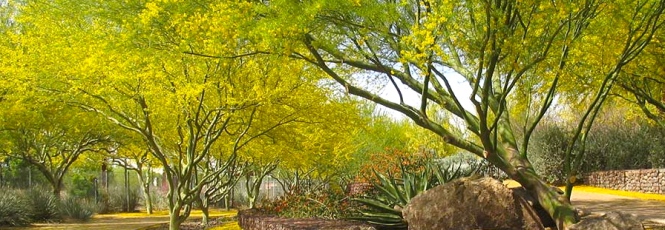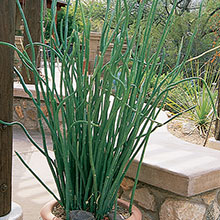Changing Landscape: Phoenix Grows Into Distinctively Desert City
Published on by Kathleen Ferris, Executive Director of Arizona Municipal Water Users Association
By Kathleen Ferris
Arizona desert cities have a distinctive style. There are few other cities where you’ll find mesquite and palo verde trees in parks, giant blue agaves and golden barrel cactus in yards, creosote and brittle bushes in medians, giant saguaros and ocotillos along the freeways. Being young cities, it took us a while to grow up and express ourselves.
Like other teenagers, there was a time when we wanted to look like everyone else. We planted Mediterranean olives and sumacs, California palms and citrus trees, and Midwest lawns and pine trees. And, like any adolescent, we didn’t smarten up overnight. It was an evolution, and sometimes a struggle, but we finally found ourselves.
Consider these City of Phoenix figures about residential landscapes. Using water consumption and other data, the city estimates that during the 1980s from 70 to 90 percent of Phoenix homes had turf landscapes. Today, that number has dropped to 10 percent.
Thirty-five years ago the old rules still applied. Deciduous trees were not for public spaces because winter visitors came to the Phoenix Metropolitan Area to see green. Palo Verde and mesquite trees looked “too hot” for visitors. Some native plants, for goodness sakes, had thorns. Neighborhood parks were to be flat, grassy, trimmed, raked and filled with evergreen trees, such as pines and sumac. Homeowners mimicked what they saw when designing their yards. Within cities, the desert was confined to preserves and botanical gardens.
It’s clear now that the 1980s marked the beginning of the end for this kind of thinking in the Valley. There was no defining moment, just a gathering of forces that led to a new perspective.
- New Breed: By the mid-1970s a new breed of architects and designers began to emerge. These young professionals considered how well projects matched their natural environments. The Southwest also was experiencing a severe drought, which helped their cause. In the desert cities, these young designers pushed the old guard’s rules for public spaces, struggling to get permission for colorful and attention grabbing desert landscape “demonstration projects.” Desert flora very slowly began appearing in city parks, around city buildings and within street medians and freeways.
 These public projects, in particular the freeways, created large-scale demand for desert nursery stock. It also gave drought tolerant and native trees and plants exposure and the opportunity to sell their beauty to commuters. People began to call the cities asking for the names of trees and plants they saw along the roadways. Then they visited their local nurseries and asked for them.
These public projects, in particular the freeways, created large-scale demand for desert nursery stock. It also gave drought tolerant and native trees and plants exposure and the opportunity to sell their beauty to commuters. People began to call the cities asking for the names of trees and plants they saw along the roadways. Then they visited their local nurseries and asked for them. - Style: This new breed of landscape architects and designers also started to attract high-end residential customers with large homes. These customers, some local celebrities, were often
 from other states and enjoyed the dramatic look of the desert. They sought out designers who could bring that colorful drama to their yards. Private desert gardens began to show up in newspapers and magazines and win prestigious landscaping awards. Premium lots now backed onto desert washes, as well as golf courses. More homeowners began asking their local nurseries for the plants they saw in these outstanding landscapes.
from other states and enjoyed the dramatic look of the desert. They sought out designers who could bring that colorful drama to their yards. Private desert gardens began to show up in newspapers and magazines and win prestigious landscaping awards. Premium lots now backed onto desert washes, as well as golf courses. More homeowners began asking their local nurseries for the plants they saw in these outstanding landscapes. - Policy: Beginning with the 1980 Arizona Groundwater Management Act, new regulations and policies reduced the amount of turf permitted in places such as parks, streetscapes and HOAs. Even golf courses and model homes were required to limit turf.
 Cities established water and desert conservation programs. Newly hired water conservation experts actively promoted the desert aesthetic. They spread the word about its beauty, its ability to attract hummingbirds and butterflies, its practicality, its water and money-saving advantages. Some cities began to offer rebates to replace turf with desert landscaping and some developed demonstration gardens to inspire homeowners. Through AMWUA, member cities shared expertise and resources, launching programs and publications to help their customers select, install and maintain desert trees and plants.
Cities established water and desert conservation programs. Newly hired water conservation experts actively promoted the desert aesthetic. They spread the word about its beauty, its ability to attract hummingbirds and butterflies, its practicality, its water and money-saving advantages. Some cities began to offer rebates to replace turf with desert landscaping and some developed demonstration gardens to inspire homeowners. Through AMWUA, member cities shared expertise and resources, launching programs and publications to help their customers select, install and maintain desert trees and plants.
 AMWUA teamed with the Arizona Nursery Association and the Arizona Landscape Contractors Association to develop and provide marketing materials and training to the industry. The industry, in turn, educated its customers about the increasingly diverse palette of desert-adapted plants available to them.
AMWUA teamed with the Arizona Nursery Association and the Arizona Landscape Contractors Association to develop and provide marketing materials and training to the industry. The industry, in turn, educated its customers about the increasingly diverse palette of desert-adapted plants available to them.
Eventually, what was once a novelty has become the norm – with room to improve.
- Designers and conservation professionals disparage too much gravel and encourage more trees and adequate plant cover.
- Untrained homeowners and landscapers can damage the potential of a desert landscape. For example, keeping desert shrubs sheared into geometric shapes results in ugly bare spots, stops them from flowering, and increases the plant’s water needs. It can eventually kill them.
- And drought-tolerant landscapes don’t always save as much water as they should save when a gardener isn’t maintaining the irrigation system or monitoring irrigation times.
We have work to do, but we’ve opened our hearts and yards to the desert. That makes us distinctive and far more water-wise. We’re growing up.
For 46 years, Arizona Municipal Water Users Association has worked to protect our member cities’ ability to provide assured, safe and sustainable water supplies to their communities. For more water information visit www.amwua.org.